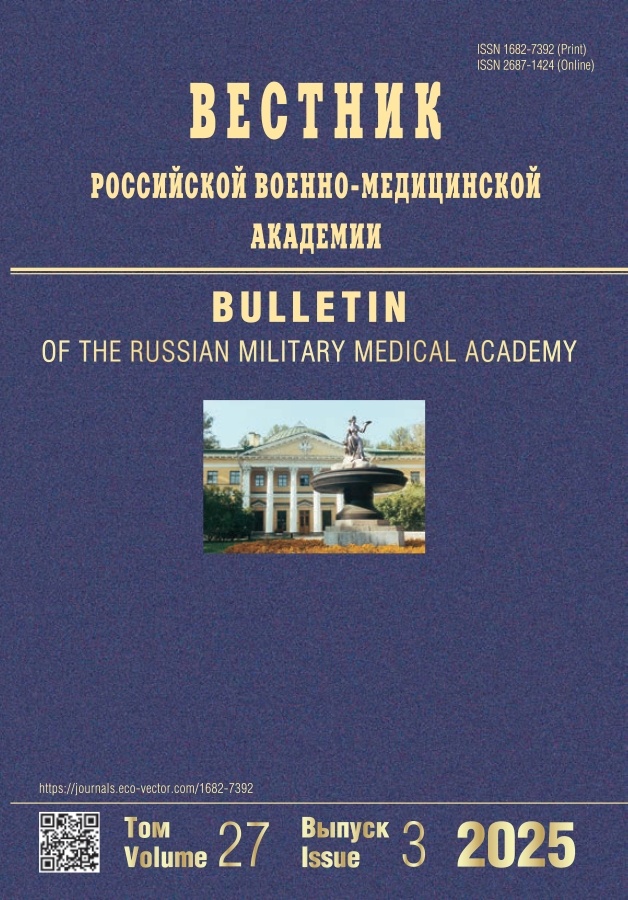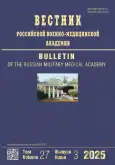Evaluation of tissue-specific effect of neurotoxic agents on metabolic processes in organs of laboratory animals in phase of long-term consequences of severe acute toxic exposure
- 作者: Potapov P.K.1,2, Shustov E.B.1, Melnikova M.V.1, Zolotoverkhaya E.A.1, Kubarskaya L.G.1, Kuznetsova N.V.1, Shemaev M.E.1, Basharin V.A.2
-
隶属关系:
- Federal State-Financed Institution Golikov Research Clinical Center of Toxicology
- Kirov Military Medical Academy
- 期: 卷 27, 编号 3 (2025)
- 页面: 375-383
- 栏目: Original Study Article
- URL: https://bakhtiniada.ru/1682-7392/article/view/319569
- DOI: https://doi.org/10.17816/brmma649818
- EDN: https://elibrary.ru/GXCFVW
- ID: 319569
如何引用文章
详细
BACKGROUND: The pathogenesis of the long-term effects of neurotoxic agents remains poorly understood. Tissue specificity, as a qualitative characteristic of the toxic effect, involves selective metabolic process remodeling in specific tissues.
AIM: The work aimed to evaluate the tissue specificity of metabolic changes in the long-term effects of acute toxic exposure.
METHODS: An experimental study was performed on rats. The toxic agents used were 1.6 mg/kg of phenylcarbamate, 11.5 g/kg of methanol, and 300 mg/kg of lead acetate. The parameters of lipid peroxidation and the antioxidant system were determined using standard biochemical techniques on day 30 after toxic exposure.
RESULTS: In the groups of intact animals and those that survived the exposure, lipid peroxidation and the antioxidant system were found to be tissue-specific. The most significant effect, which was common for body tissues, was the shift in diene conjugates, as toxic exposure was followed by a significant decrease in tissue specificity. Regarding the tissue concentration of malondialdehyde, which shows the activity of lipid peroxidation, phenylcarbamate and lead induced an increase in tissue-specific response to toxic effects. This finding showed the selective effect on individual links of oxidative stress in tissues.
CONCLUSION: Lipid peroxidation and antioxidant system activity can be considered markers for evaluating the effect of toxic agents on metabolic processes in various tissues. A higher brain tissue sensitivity to the toxic effects can be demonstrated by a higher growth rate of diene conjugates (phenylcarbamate and lead acetate), glucose-6-phosphate dehydrogenase, and superoxide dismutase (methanol). A hepatic tissue-specific response was evidenced by increased activity of glucose-6-phosphate dehydrogenase (phenylcarbamate and methanol) and decreased activity of superoxide dismutase (methanol and lead acetate). The kidneys were particularly susceptible to the impaired utilization of reduced glutathione (methanol) or its formation (lead acetate). The compensatory activation of superoxide dismutase (methanol and lead acetate) was a marker of splenic tissue-specific response.
作者简介
Petr Potapov
Federal State-Financed Institution Golikov Research Clinical Center of Toxicology; Kirov Military Medical Academy
编辑信件的主要联系方式.
Email: vmeda-nio@mil.ru
ORCID iD: 0000-0002-4602-4468
SPIN 代码: 5979-4490
MD, Cand. Sci. (Medicine)
俄罗斯联邦, 1 Bekhtereva st., Saint Petersburg, 192019; Saint PetersburgEvgeniy Shustov
Federal State-Financed Institution Golikov Research Clinical Center of Toxicology
Email: vmeda-nio@mil.ru
ORCID iD: 0000-0001-5895-688X
SPIN 代码: 9665-6670
MD, Dr. Sci. (Medicine), Professor
俄罗斯联邦, Saint PetersburgMargarita Melnikova
Federal State-Financed Institution Golikov Research Clinical Center of Toxicology
Email: vmeda-nio@mil.ru
ORCID iD: 0000-0002-2996-5151
SPIN 代码: 1296-2830
pharmacologist
俄罗斯联邦, Saint PetersburgEkaterina Zolotoverkhaya
Federal State-Financed Institution Golikov Research Clinical Center of Toxicology
Email: vmeda-nio@mil.ru
ORCID iD: 0000-0002-9708-2596
SPIN 代码: 8138-1497
Cand. Sci. (Biology)
俄罗斯联邦, Saint PetersburgLarisa Kubarskaya
Federal State-Financed Institution Golikov Research Clinical Center of Toxicology
Email: vmeda-nio@mil.ru
ORCID iD: 0000-0001-7622-0390
SPIN 代码: 9596-7227
Cand. Sci. (Biology)
俄罗斯联邦, Saint PetersburgNatalia Kuznetsova
Federal State-Financed Institution Golikov Research Clinical Center of Toxicology
Email: vmeda-nio@mil.ru
ORCID iD: 0009-0000-0876-9293
SPIN 代码: 2336-3825
biochemist
俄罗斯联邦, Saint PetersburgMikhail Shemaev
Federal State-Financed Institution Golikov Research Clinical Center of Toxicology
Email: vmeda-nio@mil.ru
ORCID iD: 0000-0001-6062-0437
SPIN 代码: 6612-3721
chemist
俄罗斯联邦, Saint PetersburgVadim Basharin
Kirov Military Medical Academy
Email: vmeda-nio@mil.ru
ORCID iD: 0000-0001-8548-6836
SPIN 代码: 4671-8386
MD, Dr. Sci. (Medicine), Professor
俄罗斯联邦, Saint Petersburg参考
- Kostrova TA. Experimental evaluation of changes in neurotrophic and apoptotic factors in the implementation of long-term consequences of acute severe poisoning by sodium thiopental. Toxicological Review. 2019;(5):49–53. doi: 10.36946/0869-7922-2019-5-49-53 EDN: MRHJDT
- Vasiliev SA, Livanov GA, Batotsyrenov BV. Features of intensive care organization for severely ill patients with acute poisonings. Medical Alphabet. 2013;2(14):49. EDN: RMXMYL
- Kutsenko SA. Fundamentals of toxicology. Saint Petersburg: Foliant; 2004. 715 p. (In Russ.)
- Ku J, Asuri P. Stem cell-based approaches for developmental neurotoxicity testing. Front Toxicol. 2024;6:1402630. doi: 10.3389/ftox.2024.1402630
- Luzhnikov EA, Sukhodolova GN. Acute poisoning in adults and children. Moscow: Eksmo; 2009. 556 p. (In Russ.)
- Shustov EB, Melnikova MV, Masterova KV, et al. Analysis of factors influencing the processes of apoptosis in the period of long-term consequences of severe acute poisoning with neurotropic toxicants. Medicine of Extreme Situations. 2025;27(1):5–14. doi: 10.47183/mes.2024-247 EDN: JFKIHX
- Zobnin YuV. Acute toxic neuropathies. Siberian Medical Journal (Irkutsk). 2008;79(4):106–110. (In Russ.) EDN: JWKQBB
- Catamanova EV. Disorders of the functional activity of the brain during occupational exposure to neurotoxicants [dissertation]. Irkutsk; 2012. 295 p. Available from: https://rusneb.ru/catalog/000199_000009_005089914/ (In Russ.)
- Kostrova TA, Lisitsky DS, Batotsyrenova EG, et al. Investigation of the consistent action of thiopental sodium the infringement of circadian rhythms on behavioral reactions of laboratory animals. Medline.ru. Russian Biomedical Journal. 2018;19:167–181. EDN: YLQMUH
- Kostrova TA. Biochemical and behavioral indicators in the long-term period after acute poisoning with neurotoxicants and their pharmacological correction (experimental study). [dissertation abstract]. Saint Petersburg; 2020. 188 p. (In Russ.)
- Naumova OV. Molecular and biochemical markers of endothelial dysfunction in chronic exposure to mercury. [dissertation abstract]. Angarsk; 2021. 150 p. (In Russ.)
- Mikhin VP. Cytoprotection in cardiology: achievements and prospects. Part 1. Russian Archive of Internal Medicine. 2014;(1):44–49. (In Russ.)
- Park Y, Kang HG, Kang SJ, et al. Combined use of multiparametric high-content-screening and in vitro circadian reporter assays in neurotoxicity evaluation. Archives of Toxicology. 2024;98(5):1485–1498. doi: 10.1007/s00204-024-03686-6
- Novikov VS, Shustov EB. Modern ideas of cell death mechanisms. Herald of Education and Science Development of Russian Academy of Natural Sciences. 2021;(4):15–27. doi: 10.26163/RAEN.2021.20.19.002 EDN: JLJVET
- Kostrova TA, Batotsyrenova EG, Kashuro VA. Evaluation of biochemical parameters in the brain tissues of rats in the long-term period after severe sodium thiopental poisoning. Medicine of Extreme Situations. 2019;21(3):429–435. (In Russ.) EDN: GGIEFQ
- Teplaya GA. Heavy metals as a factor of environmental pollution (literature review). Astrakhan Bulletin of Ecological Education. 2013;(1):182–192. EDN: PXNTRR
- Pratush A, Kumar A, Hu Z. Adverse effect of heavy metals (As, Pb, Hg, and Cr) on health and their bioremediation strategies: a review. Int Microbiol. 2018;(21):97–106. doi: 10.1007/s10123-018-0012-3 EDN: BZZEGC
- Dzugkoev SG, Dzugkoeva FS, Margieva OI. Analysis of the mechanisms of lead toxicity and their pathogenetic correction. Russian Journal of Physiology. 2022;108(5):626–635. doi: 10.31857/S0869813922050028 EDN: HKRPRI
补充文件










